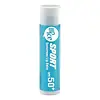Rohto Mentholatum Lip Ice Sport Sunscreen Lip Balm SPF 50+ Versus Amaterasun UV Skin Tint SPF 35 PA++++
What's inside
What's inside
 Key Ingredients
Key Ingredients

 Benefits
Benefits

 Concerns
Concerns

 Ingredients Side-by-side
Ingredients Side-by-side

Triethylhexanoin
MaskingTriisostearin
Skin ConditioningOzokerite
Emulsion StabilisingMicrocrystalline Wax
Emulsion StabilisingEthylhexyl Methoxycinnamate
UV AbsorberDiethylamino Hydroxybenzoyl Hexyl Benzoate
UV FilterHydrogenated Polyisobutene
EmollientEthylhexyl Triazone
UV AbsorberPrunus Amygdalus Dulcis Oil
Skin Conditioning4-Methylbenzylidene Camphor
UV AbsorberPolysilicone-15
UV FilterPersea Gratissima Oil
Skin ConditioningPentylene Glycol
Skin ConditioningBis-Ethylhexyloxyphenol Methoxyphenyl Triazine
Skin ConditioningAloe Barbadensis Leaf Extract
EmollientCocos Nucifera Oil
MaskingBisabolol
MaskingTocopheryl Acetate
AntioxidantMenthol
MaskingBHT
AntioxidantMenthyl Lactate
MaskingParaffinum Liquidum
EmollientPanthenol
Skin ConditioningTriethylhexanoin, Triisostearin, Ozokerite, Microcrystalline Wax, Ethylhexyl Methoxycinnamate, Diethylamino Hydroxybenzoyl Hexyl Benzoate, Hydrogenated Polyisobutene, Ethylhexyl Triazone, Prunus Amygdalus Dulcis Oil, 4-Methylbenzylidene Camphor, Polysilicone-15, Persea Gratissima Oil, Pentylene Glycol, Bis-Ethylhexyloxyphenol Methoxyphenyl Triazine, Aloe Barbadensis Leaf Extract, Cocos Nucifera Oil, Bisabolol, Tocopheryl Acetate, Menthol, BHT, Menthyl Lactate, Paraffinum Liquidum, Panthenol
Water
Skin ConditioningEthylhexyl Methoxycinnamate
UV AbsorberMethyl Trimethicone
Skin ConditioningEthylhexyl Palmitate
EmollientTitanium Dioxide
Cosmetic ColorantZinc Oxide
Cosmetic ColorantPentaerythrityl Tetraethylhexanoate
EmollientCetyl Ethylhexanoate
EmollientDimethicone
EmollientPentylene Glycol
Skin ConditioningGlycerin
HumectantCetyl PEG/PPG-10/1 Dimethicone
EmulsifyingDicaprylyl Carbonate
EmollientLauryl PEG-8 Dimethicone
Boron Nitride
AbsorbentButylene Glycol
HumectantTrimethylsiloxysilicate
EmollientMagnesium Sulfate
Phenoxyethanol
PreservativeDimethicone/Vinyl Dimethicone Crosspolymer
Skin ConditioningSynthetic Fluorphlogopite
Nylon-12
Glyceryl Tribehenate/Isostearate/Eicosandioate
EmollientAluminum Hydroxide
EmollientBetaine
HumectantDisteardimonium Hectorite
StabilisingStearic Acid
CleansingTriethoxycaprylylsilane
Sodium Hyaluronate
HumectantEthylhexylglycerin
Skin ConditioningHelianthus Annuus Seed Oil
EmollientPropanediol
SolventDisodium EDTA
1,2-Hexanediol
Skin ConditioningBHT
AntioxidantEthyl Ferulate
AntioxidantAllantoin
Skin ConditioningCaffeine
Skin ConditioningVitis Vinifera Leaf Extract
Skin ConditioningTocopherol
AntioxidantRosmarinus Officinalis Leaf Extract
AntimicrobialPentaerythrityl Tetra-Di-T-Butyl Hydroxyhydrocinnamate
AntioxidantCI 77492
Cosmetic ColorantCI 77491
Cosmetic ColorantCI 77499
Cosmetic ColorantWater, Ethylhexyl Methoxycinnamate, Methyl Trimethicone, Ethylhexyl Palmitate, Titanium Dioxide, Zinc Oxide, Pentaerythrityl Tetraethylhexanoate, Cetyl Ethylhexanoate, Dimethicone, Pentylene Glycol, Glycerin, Cetyl PEG/PPG-10/1 Dimethicone, Dicaprylyl Carbonate, Lauryl PEG-8 Dimethicone, Boron Nitride, Butylene Glycol, Trimethylsiloxysilicate, Magnesium Sulfate, Phenoxyethanol, Dimethicone/Vinyl Dimethicone Crosspolymer, Synthetic Fluorphlogopite, Nylon-12, Glyceryl Tribehenate/Isostearate/Eicosandioate, Aluminum Hydroxide, Betaine, Disteardimonium Hectorite, Stearic Acid, Triethoxycaprylylsilane, Sodium Hyaluronate, Ethylhexylglycerin, Helianthus Annuus Seed Oil, Propanediol, Disodium EDTA, 1,2-Hexanediol, BHT, Ethyl Ferulate, Allantoin, Caffeine, Vitis Vinifera Leaf Extract, Tocopherol, Rosmarinus Officinalis Leaf Extract, Pentaerythrityl Tetra-Di-T-Butyl Hydroxyhydrocinnamate, CI 77492, CI 77491, CI 77499
 Reviews
Reviews

Ingredients Explained
These ingredients are found in both products.
Ingredients higher up in an ingredient list are typically present in a larger amount.
BHT is a synthetic antioxidant and preservative.
As an antioxidant, it helps your body fight off free-radicals. Free-radicals are molecules that may damage your skin cells.
As a preservative, it is used to stabilize products and prevent them from degrading. Specifically, BHT prevents degradation from oxidation.
The concerns related to BHT come from oral studies; this ingredient is currently allowed for use by both the FDA and EU.
However, it was recently restricted for use in the UK as of April 2024.
Learn more about BHTEthylhexyl Methoxycinnamate is an organic compound that provides UVB protection. It often goes by the more common name of octinoxate. It is created from methoxycinnamic acid and 2-ethylhexanol.
Ethylhexyl Methoxycinnamate absorbs UVB rays with wavelengths between 280-320 nm. UV absorbers protect your skin by using chemical reactions to convert UV rays into heat and energy.
UVB (290-320 nm) rays emit more energy than UVA rays. They are capable of damaging DNA, causing sunburns and are thought to be linked to skin cancer.
The state of Hawaii has banned sunscreens containing octinoxate due to its potential impact on coral reefs. More research is needed to bridge gaps in this research. The European Union allows higher levels of octinoxate in sunscreens than the US and Australia.
Ethylhexyl Methoxycinnamate is oil soluble. It is not stable and may lose efficacy when exposed to sunlight.
Learn more about Ethylhexyl MethoxycinnamatePentylene glycol is typically used within a product to thicken it. It also adds a smooth, soft, and moisturizing feel to the product. It is naturally found in plants such as sugar beets.
The hydrophilic trait of Pentylene Glycol makes it a humectant. As a humectant, Pentylene Glycol helps draw moisture from the air to your skin. This can help keep your skin hydrated.
This property also makes Pentylene Glycol a great texture enhancer. It can also help thicken or stabilize a product.
Pentylene Glycol also acts as a mild preservative and helps to keep a product microbe-free.
Some people may experience mild eye and skin irritation from Pentylene Glycol. We always recommend speaking with a professional about using this ingredient in your routine.
Pentylene Glycol has a low molecular weight and is part of the 1,2-glycol family.
Learn more about Pentylene Glycol